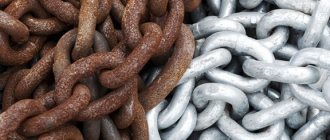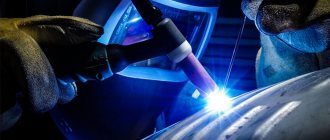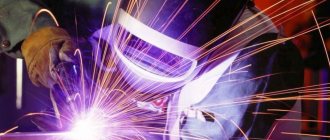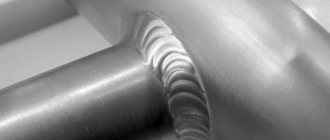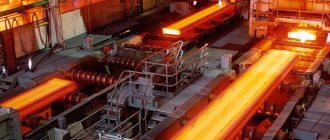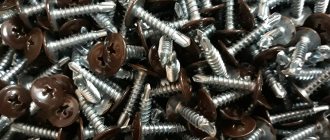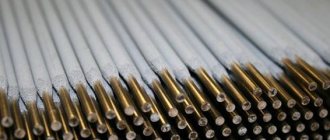ALLOYS,
materials having metallic properties and consisting of two or more chemical elements, at least one of which is a metal.
Many metal alloys have one metal as a base with small additions of other elements. The most common method of producing alloys is to solidify a homogeneous mixture of their molten components. There are other production methods, such as powder metallurgy. In principle, it is difficult to draw a clear boundary between metals and alloys, since even the purest metals contain “trace” impurities of other elements. However, metal alloys are usually understood as materials obtained by purposefully adding other components to the base metal. Also on the topic:
PHYSICAL METAL SCIENCE
Almost all metals of industrial importance are used in the form of alloys ( see
. table 12). For example, all smelted iron is almost entirely used for the production of ordinary and alloy steels, as well as cast irons. The fact is that by alloying with certain components the properties of many metals can be significantly improved. If for pure aluminum the yield strength is only 35 MPa, then for aluminum containing 1.6% copper, 2.5% magnesium and 5.6% zinc, it can exceed 500 MPa. Electrical, magnetic and thermal properties can be similarly improved. These improvements are determined by the alloy's structure—the distribution and structure of its crystals and the type of bonds between atoms in the crystals.
Many metals, say magnesium, are produced in high purity, so that you can accurately know the composition of the alloys made from it. The number of metal alloys used today is very large and is constantly growing. They are usually divided into two large categories: iron-based alloys and non-ferrous alloys. The most important alloys of industrial importance are listed below and their main areas of application are indicated.
Steel.
Also on topic:
CHEMICAL ELEMENTS IN NATURE – CYCLE AND MIGRATION
Alloys of iron and carbon containing up to 2% are called steels. Alloy steels also contain other elements - chromium, vanadium, nickel. There are far more steels produced than any other metals and alloys, and it would be difficult to list all of their possible uses. Low-carbon steel (less than 0.25% carbon) is consumed in large quantities as a structural material, while steel with higher carbon content (more than 0.55%) is used to make low-speed cutting tools such as razor blades and drills. Alloy steels are used in mechanical engineering of all types and in the production of high-speed tools. see also
METAL CUTTING MACHINES.
History of discovery
Everyone remembers the “Iron Age” from school. This is the period in history when man first learned to extract this metal from ore. The Iron Age spans the period from the 9th to the 7th century BC. This metal had a huge influence on the development of people of that time. According to its characteristics, it has replaced mixtures of non-ferrous metals. Tools, weapons, armor, materials for construction and much more were made from it. Gradually, blacksmiths began to mix it with other metals to create new materials. This is how new alloys appeared.
Copper-based alloys.
These are mainly brass, i.e. copper alloys containing from 5 to 45% zinc. Brass containing 5 to 20% zinc is called red (tompak), and brass containing 20–36% Zn is called yellow (alpha brass). Brasses are used in the production of various small parts where good machinability and formability are required. Alloys of copper with tin, silicon, aluminum or beryllium are called bronzes. For example, an alloy of copper and silicon is called silicon bronze. Phosphor bronze (copper with 5% tin and trace amounts of phosphorus) has high strength and is used to make springs and membranes.
Lead alloys.
Conventional solder (tertiary) is an alloy of approximately one part lead and two parts tin. It is widely used for connecting (soldering) pipelines and electrical wires. Antimony-lead alloys are used to make shells of telephone cables and battery plates. Alloys of lead with cadmium, tin and bismuth can have a melting point well below the boiling point of water (~70° C); They are used to make fusible plugs for valves in fire-fighting water supply sprinkler systems. Pewter, from which cutlery (forks, knives, plates) were previously cast, contains 85–90% tin (the rest is lead). Lead-based bearing alloys, called babbitts, typically contain tin, antimony and arsenic.
Areas of application
This material is used in various industries:
- Mixtures and homogeneous metal are used in mechanical engineering. Internal parts, housings, and moving mechanisms are made from them.
- Shipbuilding, aircraft manufacturing, rocketry.
- Construction - production of fasteners, consumables.
- Instrument making - manufacturing electronics for the home.
- Radioelectronics - creation of elements for electrical appliances.
- Medicine, machine tool building, chemical industry.
- Making weapons.
If a homogeneous material is not suitable for something, compounds based on it, the characteristics of which differ significantly, will do.
Aluminum alloys.
These include casting alloys (Al – Si), die-casting alloys (Al – Mg) and self-hardening high-strength alloys (Al – Cu). Aluminum alloys are economical, easily accessible, strong at low temperatures and easy to process (they are easily forged, stamped, suitable for deep drawing, drawing, extruding, casting, well welded and machined on metal-cutting machines). Unfortunately, the mechanical properties of all aluminum alloys begin to deteriorate noticeably at temperatures above approximately 175° C. However, due to the formation of a protective oxide film, they exhibit good corrosion resistance in most common aggressive environments. These alloys conduct electricity and heat well, are highly reflective, non-magnetic, harmless in contact with food (since the corrosion products are colorless, tasteless and non-toxic), explosion-proof (since they do not produce sparks) and absorb shock loads well. Thanks to this combination of properties, aluminum alloys serve as good materials for lightweight pistons; they are used in carriage, automobile and aircraft construction, in the food industry, as architectural and finishing materials, in the production of lighting reflectors, technological and household cable ducts, and in the laying of high-voltage power lines.
The iron impurity, which is difficult to get rid of, increases the strength of aluminum at high temperatures, but reduces corrosion resistance and ductility at room temperature. Cobalt, chromium and manganese weaken the embrittling effect of iron and increase corrosion resistance. When lithium is added to aluminum, the elastic modulus and strength increase, making the alloy very attractive to the aerospace industry. Unfortunately, despite their excellent strength-to-weight ratio (specific strength), aluminum-lithium alloys have low ductility.
Popular message topics
- Shevardinsky redoubt.
Monument on the Borodino Field The Battle of Borodino is one of the heroic pages of Russian history. “It’s not for nothing that all of Russia remembers Borodin’s Day!” These lines by M.Yu. Everyone knows Lermontov by heart since childhood. The memory in the hearts of people about the bloodshed will not dry out - Human skin
The human skin performs many functions. The skin protects the human body from the external environment, harmful bacteria and microbes. Scientists have found that the skin is an organ, and the largest and heaviest, - Animals of the Red Book
For a long time, man has tried to live in an idyll with the animal world. Nature completely helped man to survive and adapt to the world. But over time, people stopped appreciating it. They began to pollute water bodies, destroy fertile
Magnesium alloys.
Magnesium alloys are lightweight, characterized by high specific strength, as well as good casting properties and excellent cutting properties. Therefore, they are used to make parts for rockets and aircraft engines, car body housings, wheels, gas tanks, portable tables, etc. Some magnesium alloys, which have a high viscous damping coefficient, are used for the manufacture of moving machine parts and structural elements operating under conditions of unwanted vibrations.
Magnesium alloys are quite soft, have poor wear resistance and are not very ductile. They are easily formed at elevated temperatures, are suitable for arc, gas and resistance welding, and can also be joined by soldering (solder), bolts, rivets and adhesives. Such alloys are not particularly corrosion resistant to most acids, fresh and salt water, but are stable in air. They are usually protected from corrosion by surface coating - chrome etching, dichromate treatment, anodizing. Magnesium alloys can also be given a shiny surface or clad with copper, nickel and chromium after being dipped into molten zinc. Anodizing magnesium alloys increases their surface hardness and abrasion resistance. Magnesium is a chemically active metal, and therefore it is necessary to take measures to prevent the ignition of chips and welded parts made of magnesium alloys. see also
WELDING.
BASIC INFORMATION ABOUT METALS AND ALLOYS
Section one BASICS OF METAL SCIENCE
Chapter I BASIC INFORMATION
ABOUT METALS AND THEIR ALLOYS
General information about metals and their alloys
Currently, 107 chemical elements are known (see D.I. Mendeleev’s Periodic Table of Elements), which are divided into two main groups: metals and nonmetals (metalloids). Most of the elements (83) are metals, the distinctive features of which are opacity, specific luster, high thermal and electrical conductivity, malleability, etc. At ordinary temperatures, all metals, except mercury, are in a solid state. Metalloids do not have such properties.
Metals have the properties listed above to varying degrees, which determines their different practical uses. The most widely used materials in industry are iron, copper, aluminum, magnesium, lead, zinc and tin.
In the earth's crust, metals occupy a small place (about 15% by mass), the rest consists of oxygen (49%), silicon (26%) and other metalloids. The most common metals are aluminum (7%) and iron (5%), less common are calcium, sodium, magnesium and potassium. The content of uranium, gold, platinum and other rare metals is determined by millionths and billionths of a percent.
In technology, the word “metals” combines pure metals and alloys. Pure metals
are chemical elements usually with small additions of other elements (impurities). For example, commercial copper contains impurities of lead, bismuth, antimony, iron, arsenic, tin and other elements.
Alloys
- these are complex materials formed by combining two or more elements (including non-metals).
Pure metals have properties prescribed by nature. Alloys can be given the necessary properties, which is why they are most widespread.
In industry, metals are usually divided into two groups: ferrous and non-ferrous. Ferrous metals are iron and its alloys with carbon (steel and cast iron). Non-ferrous metals are copper, aluminum, magnesium, nickel, zinc, tin, lead, etc. and their alloys. The most common are ferrous metals (they account for more than 90% of the total mass of metals). Among the metalloids, carbon and silicon are widely used.
Metals are obtained from metal ores, which are accumulations of chemical elements in the form of simple substances or compounds. The mining industry is engaged in the extraction of ores from the bowels of the earth, and the metallurgical industry is engaged in the production of metals and alloys from ores. In accordance with the division of metals into ferrous and non-ferrous, metallurgy is also divided into ferrous and non-ferrous.
Currently, about 75 metals and a huge number of alloys are smelted.
§ 2.
Internal structure of metals and their alloys
All substances consist of atoms, and an atom is made up of a positively charged nucleus and negatively charged electrons rotating around it (Fig. 1). The nucleus contains positively charged particles - protons. The number of protons in the normal state of an atom is equal to the number of electrons, i.e. the atom is electrically neutral. The number of electrons, designated by the serial number in the periodic table of elements of D.I. Mendeleev, is different for each element. An atom, under certain conditions, can lose and gain electrons. If there are more electrons than protons, then it will be negatively charged, and if there are fewer, then positively charged. Such an electrically charged atom is called a pop.
Electrons rotate around the nucleus in orbits, the number of which is determined by the period number of the element in the periodic system.
Metals have one, two or three electrons in their outer orbit, weakly bound to the nucleus, so under the influence of positively charged atoms they can be detached from their atom, turning it into a positively charged ion. Electrons that move freely from one atom to another are called free.
Atoms of metalloids, under certain conditions, tend to fill the outer shell, that is, to attach electrons and turn into negatively charged nones.
BASIC INFORMATION ABOUT METALS AND ALLOYS
Metal materials used in technology are divided into simple and complex metals (alloys).
Simple metals
consist of one main element and a small amount of impurities of other elements. For example, technically pure copper contains from 0.1 to 1% impurities of lead, bismuth, antimony and other elements.
Alloys
- these are complex metals, representing a combination of some simple metal (alloy base) with other metals or non-metals. For example, brass is an alloy of copper and zinc. Here the base of the alloy is copper.
A chemical element that is part of a metal or alloy is called a component.
According to the number of components, alloys are divided into two-component (double), three-component (ternary), etc.
Most alloys are produced by fusing components in a liquid state.
Alloys are superior to simple metals in strength, hardness, workability, etc. That is why they are used in technology much more widely than simple metals. For example, iron is a soft metal that is almost never used in its pure form. But the most widely used in technology are alloys of iron and carbon - steel and cast iron.
All metals and alloys used in technology are divided into ferrous and non-ferrous.
To ferrous metals
include iron and its alloys (steel and cast iron). All other metals and alloys composition represent a group of non-ferrous metals.
Ferrous metals are most widely used in technology. This is due to the large reserves of iron ore in the earth's crust, the comparative simplicity of the technology for smelting ferrous metals, and their high strength.
Non-ferrous metals
are used in technology less frequently than black ones. This is explained by the insignificant content of many non-ferrous metals in the earth's crust, the complexity of the process of smelting them from ores, and insufficient strength. Non-ferrous metals are more expensive than ferrous ones. In all cases where possible, they are replaced with ferrous metals, plastics and other materials.
From a large number of non-ferrous metals and alloys in
Aluminum and copper alloys,
as well as
bearing alloys
are most widely used in agricultural machinery All metals and alloys in the solid state have
crystalline
structure, i.e. their atoms (ions) are located in a strictly defined order.
This distinguishes crystalline bodies from amorphous
bodies, in which the atoms are randomly arranged. Amorphous bodies are glass, glue, wax, etc.
If you mentally connect metal atoms with straight lines, you get a regular geometric system called a spatial crystal lattice.
From a crystal lattice one can isolate
an elementary crystal cell,
which represents a complex of atoms, by repeating which in three dimensions one can build the entire lattice.
The most common are three types of elementary crystalline cells of metals (Fig. 1): body-centered cubic
(chromium, tungsten, molybdenum, etc. have such a lattice),
face-centered cubic
(aluminum, copper, lead, etc.) and
hexagonal
(zinc, magnesium and etc.).
At the sites of metal crystal lattices there are positively charged ions held at a certain distance from each other by free electrons. This internal structure determines the characteristic features of metals, such as high electrical and thermal conductivity, plasticity (malleability), etc.
The properties of metals and alloys depend on the nature of their atoms, the type of crystal lattice, and the distance between the atoms in the lattice.
All properties of metals are divided into physical, chemical, mechanical and technological.
The physical properties of metals and alloys are determined by color, density, melting point, thermal expansion, thermal and electrical conductivity, as well as magnetic properties (Table 1). Density
metal - a value determined by the ratio of the mass of the metal to the volume it occupies. It is measured in kg/m3. To reduce the weight of the product, it is necessary to use materials with low density (alloys of magnesium, aluminum and titanium).
Melting temperature
- the temperature at which a metal changes from solid to liquid. Knowledge of the melting point of metals and alloys is necessary in metallurgy, foundry, hot metal forming, welding, soldering and other processes involving heating of metal materials.
Thermal expansion is
a change in the linear dimensions
and volume of a metal material when heated.
The difference in the magnitude of thermal linear expansion of materials is characterized by the coefficient of linear expansion a, which shows by what fraction of the original length at 0 °C the body elongated due to its heating by 1 °C. The thermal expansion of metals must be taken into account in the manufacture and operation of precision, complex instruments and instruments, the manufacture of casting molds, the laying of railway rails, etc. Thermal conductivity
- the ability of metals to transfer Heat from more heated parts of the body to less heated ones. Among metallic materials, silver, copper, and aluminum have the best thermal conductivity.
Electrical conductivity
- the ability of metals to conduct electric current. It is estimated in practice by the value of electrical resistivity p. The lower the electrical resistance, the more electrically conductive the metal material is. High electrical conductivity are those metals that conduct electric current well (silver, copper, aluminum).
The ability of metals to be magnetized under the influence of a magnetic field is called magnetic permeability.
Iron, nickel, cobalt and their alloys have strong magnetic properties.
These metals are called ferromagnetic.
The mechanical properties of metals are a set of properties that characterize the ability of metallic materials to resist external forces (loads).
On the mechanical properties of metals. relate:
strength - the ability of a material to resist external forces without destruction; elasticity
— the ability of a material to restore its original shape and size after the cessation of the external forces that caused the deformation;
plastic
— the ability of a material to change its shape and size under the influence of external forces without collapsing, and to retain the resulting deformations after the cessation of external forces;
hardness
- the ability of a material to resist the penetration of another, more solid body into it;
viscosity
— the ability of metal materials to resist rapidly increasing (shock) loads; fragility is a property inverse to viscosity;
1 creep
— the property of metallic materials to slowly and continuously deform plastically under prolonged load and high temperatures;
fatigue
is the process of gradual accumulation of damage to a material under the influence of repeated alternating stresses, leading to a decrease in durability, cracking and destruction.
The ability of metallic materials to resist fatigue is called endurance.
Mechanical properties are the main characteristics of metals and alloys, so factories have created special laboratories where various tests are carried out to determine these properties.
Mechanical tests can be divided into:
static,
in which the load acting on a metal sample or part remains constant or increases extremely slowly;
dynamic
(shock), in which the load increases quickly and acts for a short time;
test under repeated or alternating loads
- loads that change many times in magnitude or in magnitude and direction.
Let us consider the main types of tests of metals in order to determine their mechanical properties.
Technological properties characterize the ability of metals to be amenable to various types of technological processing to obtain a certain shape, size and properties: They are of great importance when choosing metal materials for the manufacture of machine parts and structures. Of the technological properties, the most important are machinability, weldability, malleability, hardenability, and casting properties.
Cutting ability is called
the ability of metals to be processed with cutting tools to give parts a certain shape, size (with the necessary accuracy) and surface finish. Cutting machinability is determined by the cutting speed, cutting force and the roughness of the machined surface. With different processing methods (turning, drilling, milling, etc.), the machinability of the same metal may be different. To improve the machinability of steels, an increased sulfur content is allowed in them, and lead, selenium and other elements are also introduced.
Weldability
is the property of a metal or alloy to form joints with the established welding technology that meet the requirements determined by the design and operation of the product.
The weldability of carbon steels deteriorates with increasing carbon content. Malleability
is the ability of a metal to be subject to pressure treatment (forging, stamping, rolling, etc.) without destruction. The malleability of a metal depends on its ductility. The more ductile the metal, the better it lends itself to pressure treatment.
Metals are malleable both when cold and when heated. Brass and aluminum alloys are forged well in a cold state, while steel is forged well in a heated state. Due to its increased brittleness, cast iron is not subject to pressure treatment.
Hardenability
- the ability of steel to accept hardening to a certain depth from the surface. The hardenability of steel is determined by the type of fracture, by measuring the hardness at various points in the cross-section of the sample, as well as by the method of end hardening.
Foundry properties
metals are determined by fluidity, shrinkage and tendency to segregation.
Flowability
is the ability of molten metal to fill a mold and produce dense castings with precise configurations.
Shrinkage
is a reduction in the volume of molten metal during solidification and subsequent cooling.
Liquation
is the heterogeneity of the chemical composition of solid metal in different parts of the casting. .
When choosing casting materials, take into account that cast iron has high casting properties: good fluidity, low shrinkage and a slight tendency to segregation. The casting properties have become worse than those of cast iron.
Chemical properties of metals
Chemical property
is the ability of metals under the influence of the environment to transform into other substances and change their properties.
Chemical properties include the ability of metals to corrode, that is, to oxidize under the influence of oxygen in air and water, to be destroyed by acids and alkalis, and to form scale when heated in an oxidizing environment.
Almost all metals are subject to corrosion For example, iron rusts in air, copper becomes covered with a green layer of oxide, aluminum with a white layer of oxide, etc.
Metals that are resistant to corrosion are called noble. These include gold and platinum. They are destroyed only in a mixture of hydrochloric and nitric acids, called “regia vodka”.
Chromium, nickel and their alloys have high corrosion resistance, while titanium and its alloys are close to noble metals in corrosion resistance.
[Chemical corrosion
occurs as a result of the chemical interaction of the metal with media that are not conductors of electric current (dry gases, oil, gasoline, kerosene, oils). In this case, the metals enter into a chemical interaction with active substances in the external environment, usually with oxygen, as a result of which oxide films appear on the surface of the metals and the product begins to deteriorate.
A typical example of chemical corrosion is gas corrosion, which is observed during heating of workpieces for forging and heat treatment, parts of furnaces and chimneys of boilers, flow parts of gas turbines, engine exhaust pipes, etc. On ships, the internal surfaces of tanks with kerosene or gasoline are exposed to chemical corrosion , tanks with oil and other similar products.
Electrochemical corrosion
occurs when a metal interacts with an electrolyte, i.e. with media that conduct electric current (alkalis, solutions of salts and acids, water and air). Corrosion of metals in the air is usually called rusting.
The phenomena during electrochemical corrosion are no different in nature from those that occur in galvanic cells. It is known that during the operation of a galvanic cell, positively charged ions of the anode pass into solution.” In this case, the anode becomes negatively charged, and the solution (electrolyte), acquiring these ions, becomes positively charged. Thus, a potential difference arises. The larger it is, the faster the ions pass from the anode into the solution and, therefore, the faster the anode is destroyed.
The potential difference that occurs on the surface of the metal in contact with the electrolyte is called electrode potential. The values of the electrode potentials of the elements are measured in relation to hydrogen, the potential of which is assumed to be zero (Table 4). Metals above hydrogen are electropositive, and metals below are electronegative.
If you build a galvanic cell from two dissimilar metals, then the one located below in the table will be destroyed. So, if zinc and iron plates are placed in an electrolyte, then the zinc will be destroyed. Each metal will be an anode to the metal above it in the table, and a cathode to all below it. Therefore, compounds of metals that differ in activity, for example iron with aluminum or copper, copper with aluminum, should not be allowed in structures operating in corrosive environments. The occurrence of corrosion on metal is facilitated by the heterogeneity of their structure, the presence of contaminants and impurities.
Metal products are subject to corrosion both during operation and storage.
Based on the nature of the effect on the metal, corrosion can be divided into continuous (uniform), local and intercrystalline.
Continuous (uniform) corrosion spreads evenly over the entire surface of the metal.
Local corrosion causes destruction of individual areas of the metal surface in the form of ulcers, spots and spots. Therefore, it is sometimes called ulcerative, spotty, or punctate. It usually occurs in places of metal defects: scratches, marks, nicks, traces of processing, etc.
Intercrystalline corrosion develops (occurs) along the boundaries of crystals without causing noticeable changes in the metal surface. This type of corrosion is the most dangerous. It leads to instant failure of parts during operation.
The intensity (speed) of corrosion depends on the chemical composition and structure of the metal, the condition of its surface, the presence of internal and external defects, the environment (its composition, temperature, speed of movement), etc. Metal with defects has a higher electrode potential than pure metal . Defects contribute to the formation of galvanic microelements and, consequently, the destruction of the base metal. The fewer defects a metal has, the higher its corrosion resistance, and vice versa. The chemical composition of a metal significantly affects its corrosion resistance. As the carbon content increases, the metal's resistance to corrosion decreases, and vice versa. The content of elements such as chromium, nickel, titanium, and copper in metals increases their corrosion resistance. Niobium and titanium increase the resistance of metals to intergranular corrosion. Corrosion of steel increases in acidic solutions and decreases in alkaline environments.
Erosion often occurs simultaneously with metal corrosion. Erosion is the mechanical destruction of a metal surface by impacts of particles of solids, water, gas, steam, air, etc. Combined corrosion and erosion destroy the metal much faster.
About 10% of all deposited metals embodied in various products, structures and machines are destroyed annually by corrosion. Therefore, the fight against corrosion is the most important national economic task. Knowledge of the chemical properties of metals allows you to choose the right one for the manufacture of products or structures operating in corrosive environments.
Corrosion of ship structures
Ship structures operate in extremely unfavorable conditions. Parts of internal combustion engines and gas turbines, furnaces and chimneys of steam boilers, shipbuilding blanks heated during processing are subject to gas corrosion, ship structures in contact with oil, gasoline, kerosene, oils are subject to chemical corrosion, ship structures located in water and a humid atmosphere, — electrochemical corrosion. Many ship structures (hull, propellers, rudders, rotating parts of turbines and pumps, pipes of most ship systems, etc.) are also subject to erosion. As a result, metal losses from corrosion in shipbuilding are quite high.
The main corrosive environment for ship structures is sea water, which contains solutions of various salts. The salinity of the oceans is approximately 35 ppm, the seas - no more than 25, rivers and lakes - no more than 0.3 ppm. The higher the concentration of salts in water, the higher the electrical conductivity and, therefore, the higher its corrosiveness. Oxygen, iodine, and bromine dissolved in seawater also contribute to its corrosiveness.
Carbon steel and cast iron are the most susceptible to corrosion in seawater. The more impurities (sulfur and phosphorus) a metal contains, the lower its corrosion resistance. Stainless steels and especially alloys based on titanium, zirconium and tantalum are resistant to corrosion.
The corrosion resistance of non-ferrous metals varies widely. Copper and its alloys (brass and bronze) have high corrosion resistance. But simple brass is susceptible to dezincification in sea water. Dezincification is a type of selective corrosion in which zinc dissolves and copper is released on the surface in the form of loose formations.
Aluminum and its alloys are resistant to corrosion in fresh water, and aluminum-magnesium alloys are also resistant to seawater if they have additional protection. Magnesium and its alloys are little resistant to corrosion in sea water, while titanium and its alloys are almost absolutely resistant to corrosion, and therefore are a valuable material for the manufacture of ship structures.
An increase in the speed of water movement increases electrochemical corrosion, and under certain conditions causes corrosion erosion, primarily of ship structures in the aft part of the ship's hull: propellers, internal surfaces of ship pipelines, etc.
The corrosion resistance of ship structures depends to a large extent on the cleanliness of their processing. The lumpy surface of welds, protruding heads of rivets and other fasteners can cause severe local corrosion. Corrosion is accelerated by the presence of scale on the surface of ship structures, even under a layer of paint.
Electrochemical corrosion of structures that combine various metals, for example steel with aluminum or copper alloys, occurs especially intensively. However, when building ships, it is impossible to do without such materials.
The underwater part of ships (usually up to the load waterline) during navigation and especially when anchored becomes overgrown with various animal or plant organisms that damage the coating of the ship's hull, which contributes to the occurrence of local corrosion. During their life, these organisms emit harmful chemical compounds: hydrogen sulfide, carbon dioxide, various acids and oxygen, which also increases the rate of corrosion.
When cleaning the underwater part of large-tonnage ships at docks, up to 200 tons of fouling products are removed, which not only contributes to corrosion, but also reduces the speed of ships, increases fuel consumption, and speeds up docking time.
Titanium alloys.
Titanium alloys are superior to both aluminum and magnesium alloys in terms of tensile strength and elastic modulus. Their density is greater than that of all other light alloys, but in terms of specific strength they are second only to beryllium. With a fairly low content of carbon, oxygen and nitrogen, they are quite plastic. The electrical conductivity and thermal conductivity of titanium alloys are low, they are resistant to wear and abrasion, and their fatigue strength is much higher than that of magnesium alloys. The creep limit of some titanium alloys at moderate stresses (about 90 MPa) remains satisfactory up to about 600 ° C, which is significantly higher than the temperature permissible for both aluminum and magnesium alloys. Titanium alloys are quite resistant to the action of hydroxides, salt solutions, nitric and some other active acids, but not very resistant to the action of hydrohalic, sulfuric and orthophosphoric acids.
Titanium alloys are forged up to temperatures of about 1150° C. They allow electric arc welding in an inert gas atmosphere (argon or helium), spot and roller (seam) welding. They are not very amenable to cutting (seizing of the cutting tool). Melting of titanium alloys must be done in a vacuum or controlled atmosphere to avoid contamination with oxygen or nitrogen impurities that cause embrittlement. Titanium alloys are used in the aviation and space industries for the manufacture of parts operating at elevated temperatures (150–430° C), as well as in some special-purpose chemical apparatus. Light armor for the cockpits of combat aircraft is made from titanium-vanadium alloys. Titanium-aluminum-vanadium alloy is the primary titanium alloy for jet engines and airframes.
In table Table 3 shows the characteristics of special alloys, and table. Figure 4 shows the main elements added to aluminum, magnesium and titanium, indicating the resulting properties.
Metal profiles, metal raw materials
Sheet metal is divided into thin sheet and thick sheet.
It is best to finish the edges of sheet metal with a planer made from a used hacksaw blade. Using an abrasive triangular stone, we grind out a corner cutout in the blade - the plane is ready.
Steel pipes are produced seamless (solid drawn) or welded (lap). The former are known as gas or steam pipes.
The most convenient way to cut a tin pipe is with a can opener. We make entry with a regular hacksaw.
Cast iron pipes are commonly used in water and sewerage systems.
The wire has three (main) or more types of sections - square, round or rectangular. Its surface can be copper-plated, tin-plated, galvanized or uninsulated. It can also be elastic or soft.
The rods are produced in round, hexagonal, square or flat sections.
The art of making light alloys yourself can be very rewarding. The most important thing is to prevent the metal from overheating.
Beryllium alloys.
A ductile beryllium alloy can be produced, for example, by embedding brittle grains of beryllium into a soft ductile matrix such as silver. The alloy of this composition was brought to a thickness of 17% of the original by cold rolling. Beryllium surpasses all known metals in specific strength. Combined with its low density, this makes beryllium suitable for missile guidance systems. The elastic modulus of beryllium is greater than that of steel, and beryllium bronzes are used to make springs and electrical contacts. Pure beryllium is used as a neutron moderator and reflector in nuclear reactors. Due to the formation of protective oxide layers, it is stable in air at high temperatures. The main difficulty with beryllium is its toxicity. It can cause serious respiratory problems and dermatitis. See also CORROSION OF METALS and articles on individual metals.
Table 1. Some important alloys (composition and mechanical properties)
| Table 1. SOME IMPORTANT ALLOYS (composition and mechanical properties) | |||||
| Typical mechanical properties | |||||
| Alloys | Composition (main elements, %) | State | Yield strength (strain 0.2%), MPa | Tensile strength, MPa | Elongation (at a length of 5 cm), % |
| Aluminum | |||||
| 3003 | 1.2 Mn, 98.8 Al | Annealed | 40 | 110 | 30 |
| Cold rolled1 | 186 | 200 | 4 | ||
| 2017 | 4.0 Cu, 0.5 Mn, 0.5 Mg, 95 Al | Annealed | 69 | 179 | 22 |
| Heat treated2 | 275 | 427 | 22 | ||
| 5052 | 2.5 Mg, 0.25 Cr, 97.25 Al | Annealed | 90 | 193 | 25 |
| Cold rolled1 | 255 | 290 | 7 | ||
| 6053 | 1.3 Mg, 0.7 Si, 0.25 Cr, 97.75 Al | Annealed | 55 | 110 | 35 |
| Heat treated3 | 220 | 255 | 15 | ||
| Alkled 2024 | Core: 2024 (4.5 Cu, 0.60 Mn, 1.5 Mg, 94.4 Al). Coating: 99.75 Al | Annealed | 76 | 179 | 20 |
| Heat treated3 | 310 | 448 | 18 | ||
| Heat treated4 | 365 | 462 | 11 | ||
| 7075 | 5.6 Zn, 2.1 Cu, 3.0 Mg, 0.3 Cr, 89.0 Al | Annealed | 100 | 228 | 17 |
| Heat treated3 | 517 | 572 | 11 | ||
| 13 | 12–13 Si, 87–88 Al | Die cast | 145 | 296 | 2,5 |
| 43 | 5.3 Si, 94.7 Al | Cast in sand. form | 55 | 130 | 8 |
| Die cast | 110 | 228 | 9 | ||
| 214 | 4 Mg, 96 Al | Cast in sand. form | 82 | 170 | 9 |
| Copper | |||||
| Red brass | 85 Cu, 15 Zn | Annealed | 100 | 310 | 43 |
| Cold rolled1 | 450 | 550 | 4 | ||
| Cartridge brass | 69 Cu, 31 Zn | Annealed | 100 | 317 | 58 |
| Cold rolled1 | 450 | 586 | 10 | ||
| Yellow brass (high) | 65 Cu, 35 Zn | Annealed | 100 | 310 | 60 |
| Cold rolled1 | 480 | 620 | 5 | ||
| Admiralty brass | 70 Cu, 29 Zn, 1 Sn | Annealed | 124 | 365 | 60 |
| Cold rolled1 | 676 | 689 | 3 | ||
| Shipbuilding brass | 60 Cu, 39 Zn, 0.75 Sn, 0.25 Pb | Annealed | 100 | 372 | 40 |
| Cold rolled1 | 270 | 427 | 30 | ||
| Munza metal | 60 Cu, 40 Zn | Annealed | 100 | 393 | 48 |
| Cold rolled1 | 410 | 552 | 9 | ||
| Aluminum bronze | 92 Cu, 8 Al | Annealed | 206 | 524 | 55 |
| Cold rolled1 | 689 | 924 | 13 | ||
| Manganese bronze | 68 Cu, 29 Zn, 1 Fe, 1 Mn, 1 Al | Annealed | 172 | 414 | 45 |
| Cold rolled1 | 344 | 586 | 20 | ||
| Phosphor bronze | 95 Cu, 5 Sn, traces P | Annealed | 124 | 310 | 50 |
| Cold rolled1 | 517 | 620 | 4 | ||
| Silicon bronze | 96 Cu, 3 Si, rest Mn, Sn, Ni or Zn | Annealed | 150 | 379 | 35 |
| Cold rolled1 | 620 | 758 | 5 | ||
| Beryllium bronze | 97.6 Cu, 2.05 Be, 0.35 Ni or 0.25 Co | Annealed | 210 | 483 | 42 |
| Cold rolled5 | 1100 | 1310 | 2 | ||
| Nickel silver | 60 Cu, 20 Zn, 20 Ni | Annealed | 138 | 310 | 35 |
| Cold rolled1 | 517 | 620 | 3 | ||
| Cupronickel | 70 Cu, 30 Ni | Annealed | 228 | 440 | 35 |
| Cold rolled | 503 | 552 | 5 | ||
| Magnesium | |||||
| AZ 92 (daumetal C) | 9 Al, 2 Zn, 0.1 Mn, 88.9 Mg | Cast in sand. form3 | 150 | 275 | 3 |
| AZ 90 (daumetal R) | 9 Al, 0.6 Zn, 0.2 Mn, 90.2 Mg | Die cast | 150 | 228 | 3 |
| AZ 80X (daumetal 01) | 8.5 Al, 0.5 Zn, 0.2 Mn, 90.8 Mg | Extruded | 228 | 338 | 11 |
| Nickel | |||||
| Monel metal | 67 Ni, 30 Cu, 1.4 Fe, 1 Mn | Annealed | 240 | 517 | 40 |
| Cold rolled1 | 689 | 758 | 5 | ||
| Inconel | 77.1 Ni, 15 Cr, 7 Fe | Annealed | 241 | 586 | 45 |
| Cold rolled1 | 758 | 930 | 5 | ||
| Iron | |||||
| Wrought iron | 2.5 slag, the rest is basic. Fe | Hot rolled | 206 | 330 | 30 |
| Technically pure iron | 99.9 Fe | Annealed | 130 | 260 | 45 |
| Carbon steel SAE 1020 | 0.2 C, 0.25 Si, 0.45 Mn, 99.1 Fe | Annealed | 276 | 414 | 35 |
| Cast carbon steel | 0.3 C, 0.4 Si, 0.7 Mn, 98.6 Fe | Cast6 | 276 | 496 | 26 |
| Cast7 | 414 | 620 | 25 | ||
| Type 302 stainless steel | 18 Cr, 8 Ni, 0.1 C, 73.9 Fe | Annealed | 207 | 620 | 55 |
| Type 420 stainless steel | 13 Cr, 0.35 C, 86.65 Fe | Annealed | 414 | 676 | 28 |
| Heat treated | 1380 | 1724 | 8 | ||
| Cast iron | 3.4 C, 1.8 Si, 0.5 Mn, 94.3 Fe | Cast | — | 174 | 0,5 |
| Nitensil | 2.7 C, 1.8 Si, 0.8 Mn, 2.3 Ni, 0.3 Cr, 92.1 Fe | Cast8 | 278 | 552 | — |
| Niresist type 2 | 2.8 C, 1.8 Si, 1.3 Mn, 20 Ni, 2.5 Cr, 71.6 Fe | Cast | — | 207 | 2 |
| Nihard | 2.7 C, 0.6 Si, 0.5 Mn, 4.5 Ni, 1.5 Cr, 90.2 Fe | Cast in sand. form | — | 379 | — |
| Chill cast | — | 517 | — | ||
| 1Vacation at max. hardness. 2 Heat treatment for solid solution. 3 Heat treatment for solid solution and aging. 4Heat treatment for solid solution, aging and hardening. 5Vacation at max. hardness and aging. 6Casting and annealing. 7Casting, water quenching, tempering at 677° C. 8Casting and heat treatment. | |||||
Table 2. Some important alloys (physical properties, characteristics and applications)
| Table 2. SOME IMPORTANT ALLOYS (physical properties, characteristics and applications) | |||||||||||
| Physical properties | |||||||||||
| Alloys | Density | Melting point (range), °C | Coeff. thermal expansion (0–100° C), 10–6/K | Thermal conductivity (0–100° C), 106 W/(mCHK) | Electrical resistivity (0°C), 10–9 OhmHm | Tensile modulus of elasticity, 103 MPa | Characteristics and Application | ||||
| Aluminum | |||||||||||
| 3003 | 2,73 | 645–655 | 22,9 | 8,32 6,70 | 98,9 125 | 68,9 | Plastic and lightweight material. Tanks, pipes, rivets, etc. | ||||
| 2017 | 2,79 | 535–640 | 23,2 | 7,41 5,23 | 111 169 | 71,7 | Aircraft manufacturing and other branches of technology where high specific strength is required | ||||
| 5052 | 2,67 | 590–650 | 23,6 | 6,00 | 144 | 70,3 | Good strength, lightweight, corrosion resistant material | ||||
| 6053 | 2,69 | 580–650 | 23,2 | 7,41 6,70 | 111 125 | 69,0 | Same | ||||
| 2024 | — | 500–640 | 23,0 | — | — | — | Durability exceeds 2017 | ||||
| 7075 | 2,80 | 480–640 | 23,2 | 5,23 | 169 | 71,7 | Strength exceeds 2024. Aircraft manufacturing | ||||
| 13 | 2,66 | 576–620 | 19,8 | 6,14 | 140 | 71,0 | Good casting properties. Excellent material for complex castings | ||||
| 43 | 2,66 | 576–630 | 22,0 | 6,32 6,32 | 136 122 | 71,0 71,0 | Good casting properties, gas-tight material. General purpose casting alloy | ||||
| 214 | 2,63 | 580–640 | 23,8 | 5,98 | 144 | 71,0 | Good mechanical properties. Excellent corrosion resistance. Kitchen and dairy utensils | ||||
| Copper | |||||||||||
| Red brass | 8,75 | 1023 | 17,6 | 6,85 | 143 | 103 | Corrosion resistant. Water pipes, fittings | ||||
| Cartridge brass | 8,50 | 938 | 20,0 | 5,17 | 204 | 97 | Cartridge cases and other deep-drawn products | ||||
| Yellow brass (high) | 8,47 | 932 | 18,9 | 5,17 | 204 | 97 | General purpose brass. Good mechanical characteristics. | ||||
| Admiralty brass | 8,54 | 934 | 18,4 | 4,73 | 214 | 103 | Corrosion resistant. Condenser pipes | ||||
| Shipbuilding brass | 8,42 | 885 | 20,1 | 5,00 | 214 | 103 | Resistant to salt water. Shipbuilding | ||||
| Munza metal | 8,40 | 904 | 19,4 | 5,42 | 184 | 90 | Good high temperature properties and corrosion resistance | ||||
| Aluminum bronze | 7,78 | 1040 | 16,6 | 3,00 | 357 | 103 | High strength alloy, corrosion resistant. Propellers, gears | ||||
| Manganese bronze | 8,36 | 896 | 20,1 | 4,36 | 214 | 103 | Increased strength. Pipeline fittings | ||||
| Phosphor bronze | 8,86 | 1050 | 16,9 | 3,52 | 290 | 103 | High fatigue strength. Springs, membranes | ||||
| Silicon bronze | 8,54 | 1018 | 17,1 | 1,40 | 816 | 103 | High strength and fatigue resistance, corrosion resistance | ||||
| Beryllium bronze | 8,23 | 954 | 16,6 | 4,00 | — | — | Exceptionally high fatigue strength. Springs, membranes | ||||
| Nickel silver | 8,75 | 1110 | 16,2 | 1,45 | 893 | 128 | Corrosion resistant white metal. Basic material for silver plated utensils | ||||
| Cupronickel | 8,94 | 1227 | 15,3 | 1,25 | 1122 | 139 | Corrosion resistance. Condenser pipes, salt water pipes | ||||
| Magnesium | |||||||||||
| AZ 92 (daumetal C) | 1,82 | 599 | 25,2 | 2,89 | 490 | 44,8 | Light alloy for sand casting and multiple molds | ||||
| AZ 90 (daumetal R) | 1,81 | 604 | 25,2 | 2,98 | 520 | 44,8 | Lightweight die casting alloy | ||||
| AZ 80X (daumetal 01) | 1,80 | 610 | 25,2 | 3,30 | 444 | 44,8 | Light alloy for extrusion | ||||
| Nickel | |||||||||||
| Monel metal | 8,84 | 1299–1349 | 14,0 | 1,12 | 1480 | 179 | Corrosion resistant. Kitchen and hospital equipment | ||||
| Inconel | 8,51 | 1393–1427 | 11,5 | 0,64 | 3000 | 214 | Heat and corrosion resistant alloy | ||||
| Iron | |||||||||||

